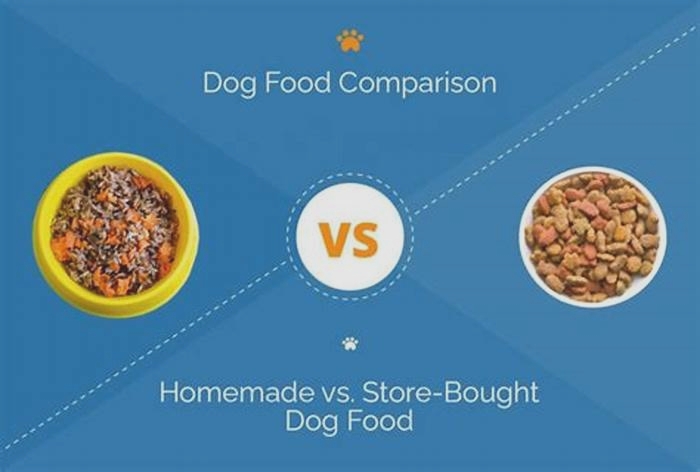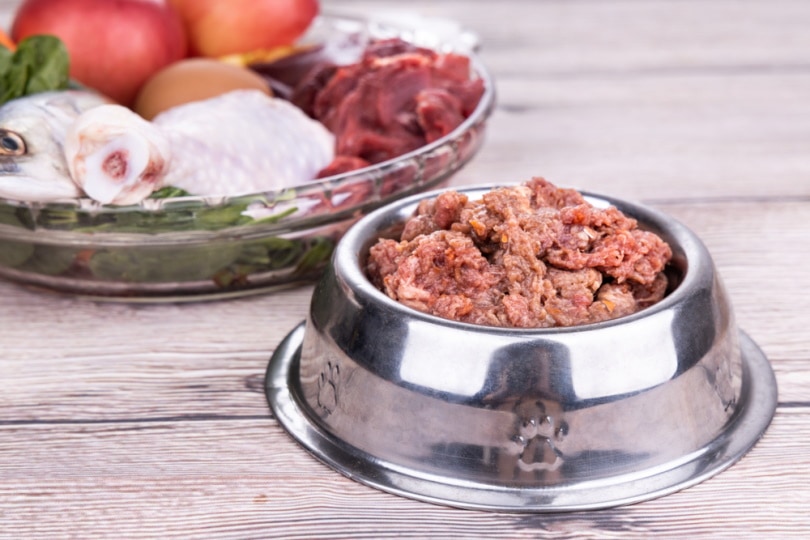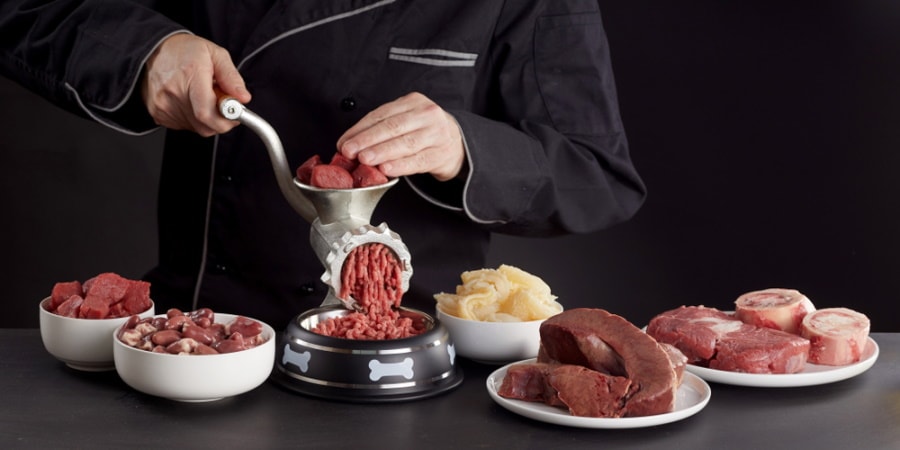homemade dog food vs store bought

Homemade Dog Food vs Store-Bought: Pros & Cons
The information is current and up-to-date in accordance with the latest veterinarian research.
Learn moreDog owners want to give their dogs the best food possible, which may lead some people to wonder which is better for them: homemade or store-bought food? In this article, we compare both in detail.
In almost all aspects, store-bought wins over homemade dog food. Its certainly the more popular option and has more benefits for dogs and their owners. If youre looking to save money, time, and effort while making sure your dog is getting quality nutrition, store-bought dog food is the way to go.
Homemade dog food requires meticulous planning. Gathering the ingredients to use can cost more than a bag of dog food from the store, and busy dog owners may not have the time necessary to dedicate to cooking. If you run out of time, your dog has no food.
While some dog owners choose homemade food because they believe that its healthier than store-bought, this isnt always the case either. Read on for more information about both options to see which one is right for you.

At a Glance
Homemade Dog Food
- You can see and know all the ingredients in the food
- Appeases picky eaters with fresh flavors
- No filler ingredients
- No preservatives
- Can be a healthy option
- You can tailor recipes for dogs with health issues
Store-Bought Dog Food
- Convenient
- Vast array of options
- Formulated with correct nutrients
- Approved for safety
- Affordable
- Lasts for a long time

Overview of Homemade Dog Food

Cooking for your dog enables you to give them various flavors each day so they dont get bored of the same thing. You can also feed them fresh food for every meal, which some dog owners feel is healthier. Homemade dog food includes no preservatives because it isnt made to last for weeks on a shelf. If your dog is allergic to certain ingredients, you can make sure these foods arent included. Recipes can also be customized for weight loss and other health concerns.
However, homemade dog food has to have the right balance of nutrients in it, or the results can be devastating. You cant just cook chicken and vegetables for your dog and call it a day. You may need to use supplements to fill nutritional gaps, and these can be expensive.
Before you begin, you need the right advice from a veterinary nutrition expert who can offer scientifically backed recipes that will give your dog the correct nutrients. Homemade diets often lack iron, calcium, riboflavin, and vitamins E and B12. These are all necessary for a dogs health. To prevent this, you can purchase a DIY homemade food package like the one offered by The Farmers Dog.
Making homemade food can also be time-consuming, and if you run out of time, you wont have any food for your dog. Keeping store-bought food on hand in case of this circumstance might seem like a solution, but dogs can get stomach issues and diarrhea from switching foods too quickly.
Pros
- Ingredients are always fresh
- You know whats in the food
- Recipes dont include preservatives
- Dogs wont get bored of the flavor
Cons
- Time-consuming
- May lack necessary nutrients
- Ingredients need to always be kept on-hand
- Nutritional supplements can be costly
- Requires a great deal of work
- Education on dog nutrition is needed before starting

Overview of Store-Bought Dog Food

Store-bought dog food offers the right amount of nutrition for dogs of all breeds, sizes, and life stages. If you look for a food that meets the requirements of the Association of American Feed Control Officials, you can trust that the manufacturers followed the proper nutritional guidelines for the foods targeted dogs. Senior dogs need different nutrition than puppies, which is another advantage that store-bought food has over homemade food. The life stages are already balanced appropriately to provide dogs of all ages with everything that they need.
Store-bought dog food is convenient. Unopened dry and wet food can stay on a shelf for a long time. Its best to check the expiration date printed on the label to see how long this period is, but the fact that its shelf-stable enables you to buy it in bulk or stock up when the food is on sale. No preparation is involved. You can just open it and feed your dog.
One major issue with dog food, though, is that it can have recalls. Companies can discover that their manufacturing process may have resulted in food contamination. In these cases, the food should stop being offered to your dog immediately and be returned to the place of purchase for a refund.
If your dog suffers from allergies, reading through countless ingredient lists can be time-consuming. Dogs with specific health issues need certain types of food, which can be hard to locate even among the seemingly endless number of options.
Pros
- Nutritionally balanced and complete
- Shelf stable
- Cost-effective
- Available for all life stages, breeds, sizes, and ages
- Convenient
Cons
- Occasional recalls
- May be difficult to narrow down a selection
- May go stale before its used once opened

What Are the Differences Between Them?
Health Benefits
Both homemade and store-bought dog food have health benefits. Homemade dog food contains only the ingredients that you choose to add, and you know everything that your dog is consuming. The nutrition is controlled by you. However, sometimes it can be impossible to include every nutrient that is essential for your dogs health in a homemade recipe if it is not properly supplemented.
Store-bought dog food is required by law to meet nutritional and safety standards in production. The food is nutritionally complete and balanced. Learning how to make homemade recipes requires a great deal of time, dedication, and education to be sure that youre not eliminating anything essential from your dogs diet.

Nutrition
Store-bought food provides an easy solution to offer a complete and balanced diet to your dog. Homemade food also offers benefits: If you make a nutritionally complete recipe for your dog, they will get the proper amount of nutrition. But this is difficult to do, you need balanced, approved recipes and supplementation to guarantee that they are receiving the right number of vitamins and minerals.
Safety
In a homemade dog food recipe, you can see everything thats included. While that doesnt mean the food is never at risk of contamination, even in your own kitchen, the risk is reduced when you can control the food and how its prepared.
Store-bought dog food can always be recalled if there is an issue in the production, so we give the edge to homemade dog food when it comes to safety but only slightly.

Price
Store-bought food is an easy way to offer a complete and balanced diet to your dog. Homemade food also offers benefits: if you make a nutritionally complete recipe for your dog, they will get the proper amount of nutrition. However, this is difficult to do, as you need balanced, vet-approved recipes and supplementation to guarantee that your dog is receiving the right amount of vitamins and minerals.
Keeping up with these ingredients can be expensive. You also want to make sure youre adding the correct number of vitamins and minerals to the food, which means you likely need to purchase supplements. If youre making two or three meals every day for your dog, the costs of the meat, produce, and supplements can add up quickly.

Conclusion
When it comes to homemade dog food vs store-bought dog food, there are advantages and disadvantages to both. Store-bought food stands out as the better choice in terms of price and convenience.
Homemade dog food requires a great deal of work, both in learning how to make it correctly and then preparing the recipes. That doesnt mean you should be discouraged from trying it, just that you should do it the right way. If done correctly, you will know exactly what you are feeding your dog and mix in some love, too. We recommend that you get advice from a veterinary nutritionist and speak to your vet before switching your dog to a homemade diet.
We hope that this article was informative and helped you decide which type of food is best for your dog.
The Real Cost Of Homemade Dog Food vs Store Bought
There are no two ways about it looking after a dog is not always easy on the wallet. We take a look at the real cost of making your own dog food at home VS buying it from the shop.
Whether its vet bills, toys or just feeding your pooch every week, there are a considerable number of costs associated with being a dog owner.

If youre looking for a way to reduce your pet bills without compromising your dogs health, your dogs diet may be a good place to start. The obvious choice is to downgrade the brand of dog food youre buying.
This may make food last longer, but it will likely do your dog more harm than good. For starters, lower grade dog food brands are usually bulked up with fillers like stodgy carbohydrates, leaving less room for essential nutrients and potentially causing tummy problems.
Theres also the possibility your dog might simply turn its nose up at it nobody wants inferior food!
As a cheaper, healthier alternative, budget friendly homemade dog food may be the way to go.
Homemade dog food vs kibble whats the difference?
Kibble is a simple alternative for dog owners who are short of time. Its made up of dried dog meats made into small, bitesize biscuits that can be poured easily into a bowl. Some owners feed their dogs kibble only, while others like to mix it up with wet food, gravy, salmon oil or even just meat.
The benefit of kibble is that its quick, easy, and has been fortified with all the vitamins and minerals your dog needs to stay healthy. On the downside, some lower grade brands may be bulked up with non-nutritious ingredients, or at worse, with unnatural preservatives that are going to do your dog no favours. Kibble can be very cheap and accessible, but that doesnt always make it the best.
Homemade raw food
The other argument against kibble is that it involves heating meats to produce the finished product. A new diet that has risen to prominence since the 90s, the BARF diet, posits that raw homemade food is the way forward. It stands for Bones and Raw Food or Biologically Appropriate Raw Food, and some nutritionists claim that heating food strips it of its nutrients and essential enzymes.
For this reason, they recommend a homemade diet of raw food, to include muscle meats, organ meat like liver, eggs, yoghurt, green vegetables and even fruit. This provides the same mix of vitamins and minerals your dog needs for a healthy coat and energetic vigour with none of the bad stuff.
Is homemade dog food more expensive?
This is a contentious issue, and ultimately, its down to your buying choices. When it comes to homemade foods for dogs, you need to err on the side of caution. This is because so much of it involves raw meat. Based on this, its best to buy only the highest quality meats, which can be costly.
The second thing that homemade dog food could cost you is your time. Again, this depends how valuable it is to you youll need to spend time doing meal prep in the kitchen before you feed your dog. On the plus side, there are plenty of healthy homemade dog food recipes that can be prepared and frozen in advance. All you need to do is defrost them in the fridge 24 hours before serving.
For those will a little extra budget and no time, you may even be able to get raw Dog food, or gently cooked fresh dog food, delivered directly to your door in daily or weekly batches. This saves you time, but is undoubtedly the most expensive option.
How to choose the most affordable homemade dog food
You could find that you save yourself a substantial amount of money when switching to homemade food. If youre prone to buying expensive brands, buying in bulk or throwing out dog food thats not been eaten, the pennies could quickly add up.
Buying natural ingredients is just the same as adding to your weekly shop. It may even save you money on delivery costs (no more help needed carrying huge kibble bags!) or save you time visiting specialist pet stores.
To keep your dog dinners within your budgets, try these tips:
- Get your meat from the local butcher. This is oftentimes cheaper than supermarkets and will be markedly higher in quality. Whats more, once youve built up a friendship with your butcher, you may find he/she even throws in extras or gives you scraps (which are totally fine for dogs but perhaps less appealing to humans) for free or for lower amounts.
- Think about how youre emulsifying your foods. A classic homemade dog food recipe will result in handmade patties. You can stick these together with high-cost emulsifiers like olive oil, but youll get the same result and health benefit from using low costs eggs.
- Buy items that wont go out of date in bulk. For example, flaxseeds provide huge nutritional benefits for dogs, particularly for their digestive systems. You can store these for a good amount of time and get reduced rates when buying online or from wholesalers.
- Try frozen. As we mentioned above, you can freeze homemade dog food recipes, so you can also use frozen vegetables in your food prep. Often these are a healthier choice for your dog theyre frozen at source from the moment theyre picked, so you know theyre fresh. Whats more, theyre also lower in sodium than pre-packaged dog foods or tinned vegetables.
- Buy fresh ingredients and then freeze the patties. You can save time and money, ensuring no meat goes to waste, by doing meal prep at the beginning of the week.
Try this homemade dog food recipe
You can vary the amounts for each ingredient depending on the size of your dog.
No serving should weigh more than 2% of your dogs body weight.
Add raw beef, eggs, yoghurt, flaxseeds, spinach, chopped apple and carrots together. You can even spice it up with organ meats like liver. Make sure its all blended together in a food processor, and add a drop of olive oil if its not sticking. Ensure at least 25% of the recipe is protein and meat.
Worried about how to flavour homemade dog food? If youre slowly making the transition, your dog may need some convincing. You can season your recipes with chopped tomatoes, cayenne pepper (in very small servings!) or parsley.
Each of these has its own nutritional benefit, from heart health to anti-inflammation. Avoid onions and common dog food around the house which are poisonous to dogs at all costs these include things like macadamia nuts, grapes and raisins.
What to know before you switch to homemade food
When done right, homemade food can be a budget-friendly alternative to pre-packaged dog food. However, you have to be committed to spending time preparing your meals, and the change might come as a shock at first. If you are making the switch, remember:
- Introduce the new diet slowly try building up by adding the raw food to his usual food a little at a time, building up to one meal per day to avoid stomach upsets.
- Only use high-quality fresh meat to avoid the danger of bacteria in raw food
- Dont switch back to store-bought dog food straight away, as this could upset your dogs stomach even more
- Keep an eye on how your dogs health changes look at the silkiness of its coat, its skin, teeth and size of stools
- Make a budget checklist before you commit to changing the diet. You should weigh up the costs of dog food versus homemade ingredients to avoid any nasty shocks.
We all want whats best for our dog, but this comes with sacrifices. If youre willing to put in the hours, you may just find that homemade food pays for itself.
